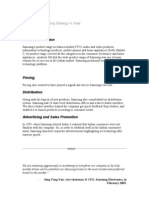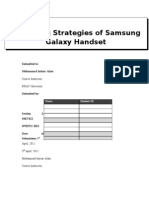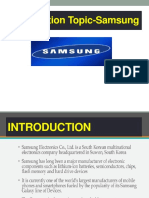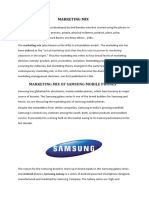0% found this document useful (0 votes)
74 views5 pagesCentre For Management Studies: Comprehensive Poject Work Mba CP 402
This document is a marketing project on Samsung's strategies in the Indian mobile phone market. It discusses Samsung surpassing Sony as a top global brand and becoming a leader in digital technologies. The project aims to study Samsung's marketing mix, product range, customer satisfaction, competitors, and promotional tools in India. It will analyze data and compare Samsung phones. The document provides an introduction to Samsung and its history and goals to be #1 in various product categories including semiconductors. It also shows Samsung's market share in India is 7%, third largest behind Nokia and Sony.
Uploaded by
Mohd JavedCopyright
© Attribution Non-Commercial (BY-NC)
We take content rights seriously. If you suspect this is your content, claim it here.
Available Formats
Download as DOC, PDF, TXT or read online on Scribd
0% found this document useful (0 votes)
74 views5 pagesCentre For Management Studies: Comprehensive Poject Work Mba CP 402
This document is a marketing project on Samsung's strategies in the Indian mobile phone market. It discusses Samsung surpassing Sony as a top global brand and becoming a leader in digital technologies. The project aims to study Samsung's marketing mix, product range, customer satisfaction, competitors, and promotional tools in India. It will analyze data and compare Samsung phones. The document provides an introduction to Samsung and its history and goals to be #1 in various product categories including semiconductors. It also shows Samsung's market share in India is 7%, third largest behind Nokia and Sony.
Uploaded by
Mohd JavedCopyright
© Attribution Non-Commercial (BY-NC)
We take content rights seriously. If you suspect this is your content, claim it here.
Available Formats
Download as DOC, PDF, TXT or read online on Scribd
/ 5













































































